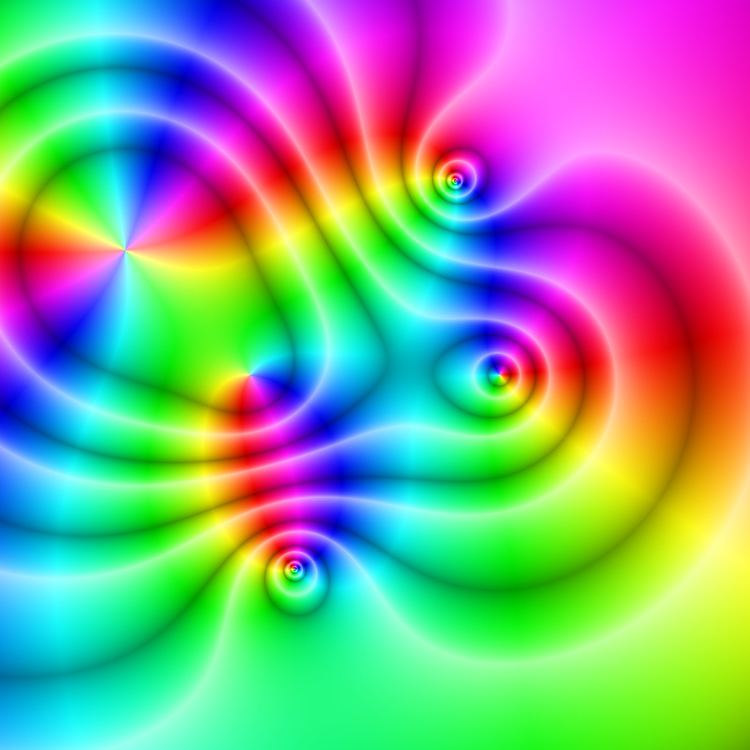 | ||
Complex analysis, traditionally known as the theory of functions of a complex variable, is the branch of mathematical analysis that investigates functions of complex numbers. It is useful in many branches of mathematics, including algebraic geometry, number theory, analytic combinatorics, applied mathematics; as well as in physics, including hydrodynamics and thermodynamics and also in engineering fields such as nuclear, aerospace, mechanical and electrical engineering.
Contents
As a derivable function of a complex variable is equal to the sum of its Taylor series (that is, it is analytic), complex analysis is particularly concerned with analytic functions of a complex variable (that is, holomorphic functions).
History
Complex analysis is one of the classical branches in mathematics, with roots in the 19th century and just prior. Important mathematicians associated with complex analysis include Euler, Gauss, Riemann, Cauchy, Weierstrass, and many more in the 20th century. Complex analysis, in particular the theory of conformal mappings, has many physical applications and is also used throughout analytic number theory. In modern times, it has become very popular through a new boost from complex dynamics and the pictures of fractals produced by iterating holomorphic functions. Another important application of complex analysis is in string theory which studies conformal invariants in quantum field theory.
Complex functions
A complex function is one in which the independent variable and the dependent variable are both complex numbers. More precisely, a complex function is a function whose domain and range are subsets of the complex plane.
For any complex function, both the independent variable and the dependent variable may be separated into real and imaginary parts:
z = x + iy andw = f (z) = u (x, y) + iv (x, y)where x, y ∈ ℝ and u (x, y), v (x, y) are real-valued functions.In other words, the components of the function f (z),
u = u (x, y) andv = v (x, y)can be interpreted as real-valued functions of the two real variables, x and y.
The basic concepts of complex analysis are often introduced by extending the elementary real functions (e.g., exponential functions, logarithmic functions, and trigonometric functions) into the complex domain.
Holomorphic functions
Holomorphic functions are complex functions, defined on an open subset of the complex plane, that are differentiable. In the context of complex analysis, the derivative of
Although superficially similar in form to the derivative of a real function, the behavior of complex derivatives and differentiable functions is significantly different. In particular, for this limit to exist, the value of the difference quotient must approach the same complex number, regardless of the manner in which we approach
An important property that characterizes holomorphic functions is the relationship between the partial derivatives of their real and imaginary components, known as the Cauchy-Riemann conditions. If
Holomorphic functions exhibit some remarkable features. For instance, Picard's theorem asserts that the range of an entire function can only take three possible forms:
See also: analytic function, coherent sheaf and vector bundles.
Major results
One of the central tools in complex analysis is the line integral. The line integral around a closed path of a function that is holomorphic everywhere inside the area bounded by the closed path is always zero, which is what the Cauchy integral theorem states. The values of such a holomorphic function inside a disk can be computed by a path integral on the disk's boundary, as shown in (Cauchy's integral formula). Path integrals in the complex plane are often used to determine complicated real integrals, and here the theory of residues among others is applicable (see methods of contour integration). A "pole" (or isolated singularity) of a function is a point where the function's value becomes unbounded, or "blows up". If a function has such a pole, then one can compute the function's residue there, which can be used to compute path integrals involving the function; this is the content of the powerful residue theorem. The remarkable behavior of holomorphic functions near essential singularities is described by Picard's Theorem. Functions that have only poles but no essential singularities are called meromorphic. Laurent series are the complex-valued equivalent to Taylor series, but can be used to study the behavior of functions near singularities through infinite sums of more well understood functions, such as polynomials.
A bounded function that is holomorphic in the entire complex plane must be constant; this is Liouville's theorem. It can be used to provide a natural and short proof for the fundamental theorem of algebra which states that the field of complex numbers is algebraically closed.
If a function is holomorphic throughout a connected domain then its values are fully determined by its values on any smaller subdomain. The function on the larger domain is said to be analytically continued from its values on the smaller domain. This allows the extension of the definition of functions, such as the Riemann zeta function, which are initially defined in terms of infinite sums that converge only on limited domains to almost the entire complex plane. Sometimes, as in the case of the natural logarithm, it is impossible to analytically continue a holomorphic function to a non-simply connected domain in the complex plane but it is possible to extend it to a holomorphic function on a closely related surface known as a Riemann surface.
All this refers to complex analysis in one variable. There is also a very rich theory of complex analysis in more than one complex dimension in which the analytic properties such as power series expansion carry over whereas most of the geometric properties of holomorphic functions in one complex dimension (such as conformality) do not carry over. The Riemann mapping theorem about the conformal relationship of certain domains in the complex plane, which may be the most important result in the one-dimensional theory, fails dramatically in higher dimensions.
